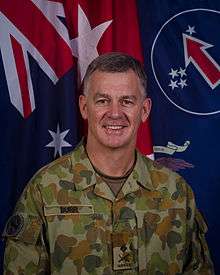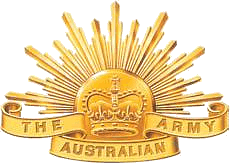Chief of Army (Australia)
| Chief of Army | |
|---|---|
|
| |
| Style | Lieutenant General |
| Member of | Australian Defence Force |
| Reports to | Chief of the Defence Force |
| Term length | Four years (renewable) |
| Inaugural holder | Major General Sir Edward Hutton |
| Formation | 29 January 1902 |
The Chief of Army is the most senior appointment in the Australian Army, responsible to both the Chief of the Defence Force (CDF) and the Secretary, Department of Defence (SECDEF). The rank associated with the position is lieutenant general (3-star).
Lieutenant General Richard Burr, the incumbent Chief of Army, has held the post since 2 July 2018.
History
The first Commander of the Australian Army was titled General Officer Commanding, Australian Military Forces, in line with the usual British practice of the time.[1] Experience soon showed that the position concentrated more power than the Ministers for Defence—of whom there were twelve in as many years in 1901–1913—liked.[2] Moreover, the British Army had encountered administrative problems in the Second Boer War which led to the abolition of the position of Commander-in-Chief of the Forces there in 1904, and its replacement by an Army Board.[3]
In 1904, Minister for Defence Anderson Dawson commissioned a report which recommended a similar system for Australia, with a Military Board consisting of four military members, the minister, and a finance member. This was implemented by his successor, James Whiteside McCay. However instead of creating a Chief of the General Staff as per the report, McCay's Military Board consisted of only three military members, the Deputy Adjutant General, the Chief of Ordnance, and the Chief of Intelligence.[4] The post of Chief of the General Staff was finally created by the new Minister of Defence, George Pearce, in 1909, with Colonel William Bridges becoming the first Chief of the General Staff. The military members of the Military Board then became the Chief of the General Staff, Adjutant General, Chief of Ordnance, and Quartermaster General.[5]
During the Second World War, the threat of invasion led to a reversion to the old system. A Commander in Chief, General Sir Thomas Blamey, was appointed, and the Military Board was suspended, with its powers being transferred to the Commander in Chief. The post of Chief of the General Staff remained, but was now subordinate to the Commander in Chief.[6] This was successful from a military point of view but the problem of a concentration of power recurred and, after the war ended, the government decided to re-form the Military Board. Blamey was replaced by Lieutenant General Vernon Sturdee in 1945 and the next year the post of Commander in Chief was again abolished, with Sturdee becoming Chief of the General Staff.[7]
The system continued until the reforms of Arthur Tange in 1973. The three services were unified under the Department of Defence. The Military Board was abolished and the Chief of the General Staff became subordinate to the Chief of the Defence Force Staff and the Secretary of Defence.[8] Reflecting this change from a staff to a command role, the post was renamed Chief of Army in 1997.[9]
Appointees
The following table lists all those who have held the post of Chief of Army or its preceding positions. Ranks and honours are as at the completion of their tenure.[10]
| Rank and prefix | Name | Postnominal(s) | Term began | Term ended | Time in appointment |
|---|---|---|---|---|---|
| General Officer Commanding Australian Military Forces | |||||
| Major General Sir | Edward Hutton | KCB, KCMG | 29 January 1902 | 10 November 1904 | 1 year, 285 days |
| Major General | Harry Finn | CB, DCM | 11 November 1904 | 12 January 1905 | 62 days |
| Chief of the General Staff | |||||
| Colonel | William Bridges | CMG | 1 January 1909 | 25 May 1909 | 144 days |
| Major General Sir | John Hoad | KCMG | 26 May 1909 | 30 May 1911 | 2 years, 4 days |
| Lieutenant Colonel | Francis Adrian Wilson | DSO | 1 June 1911 | 10 May 1912 | 344 days |
| Brigadier General | Joseph Maria Gordon | CB | 11 May 1912 | 31 July 1914 | 2 years, 81 days |
| Colonel | James Gordon Legge | CMG | 1 August 1914 | 23 May 1915 | 295 days |
| Colonel | Godfrey Irving | 24 May 1915 | 31 December 1915 | 221 days | |
| Colonel | Hubert Foster | 1 January 1916 | 30 September 1917 | 1 year, 272 days | |
| Major General | James Gordon Legge | CB, CMG | 1 October 1917 | 31 May 1920 | 2 years, 243 days |
| Major General Sir | Brudenell White | KCMG, KCVO, CB, DSO | 1 June 1920 | 10 June 1923 | 3 years, 9 days |
| General Sir | Harry Chauvel | GCMG, KCB | 11 June 1923 | 15 April 1930 | 6 years, 308 days |
| Major General | Walter Coxen | CB, CMG, DSO | 16 April 1930 | 30 September 1931 | 1 year, 167 days |
| Major General Sir | Julius Bruche | KCB, CMG | 1 October 1931 | 20 April 1935 | 3 years, 201 days |
| Lieutenant General | John Lavarack | CB, CMG, DSO | 21 April 1935 | 12 October 1939 | 4 years, 174 days |
| Lieutenant General | Ernest Squires | CB, DSO, MC | 13 October 1939 | 26 January 1940 | 105 days |
| Major General | John Northcott | CB | 27 January 1940 | 17 March 1940 | 50 days |
| General Sir | Brudenell White | KCB, KCMG, KCVO, DSO | 18 March 1940 | 13 August 1940 | 148 days |
| Lieutenant General | Vernon Sturdee | CBE, DSO | 14 August 1940 | 9 September 1942 | 2 years, 26 days |
| Lieutenant General | John Northcott | CB | 10 September 1942 | 30 November 1945 | 3 years, 81 days |
| Lieutenant General Sir | Vernon Sturdee | KBE, CB, DSO | 1 December 1945 | 16 April 1950 | 4 years, 136 days |
| Lieutenant General Sir | Sydney Rowell | KBE, CB | 17 April 1950 | 15 December 1954 | 4 years, 242 days |
| Lieutenant General Sir | Henry Wells | KBE, CB, DSO | 16 December 1954 | 22 March 1958 | 3 years, 96 days |
| Lieutenant General Sir | Ragnar Garrett | KBE, CB | 23 March 1958 | 30 June 1960 | 2 years, 99 days |
| Lieutenant General Sir | Reg Pollard | KBE, CB, DSO | 1 July 1960 | 20 January 1963 | 2 years, 203 days |
| Lieutenant General Sir | John Wilton | KBE, CB, DSO | 21 January 1963 | 18 May 1966 | 3 years, 117 days |
| Lieutenant General Sir | Thomas Daly | KBE, CB, DSO | 19 May 1966 | 18 May 1971 | 4 years, 364 days |
| Lieutenant General Sir | Mervyn Brogan | KBE, CB | 19 May 1971 | 19 November 1973 | 2 years, 184 days |
| Lieutenant General | Frank Hassett | AC, CB, CBE, DSO, LVO | 20 November 1973 | 23 November 1975 | 2 years, 3 days |
| Lieutenant General | Arthur MacDonald | CB, OBE | 24 November 1975 | 20 April 1977 | 1 year, 147 days |
| Lieutenant General Sir | Donald Dunstan | KBE, CB | 21 April 1977 | 14 February 1982 | 4 years, 304 days |
| Lieutenant General Sir | Phillip Bennett | KBE, AO, DSO | 15 February 1982 | 12 February 1984 | 1 year, 362 days |
| Lieutenant General | Peter Gration | AO, OBE | 13 February 1984 | 12 April 1987 | 3 years, 58 days |
| Lieutenant General | Lawrence O'Donnell | AC | 13 April 1987 | 12 April 1990 | 2 years, 364 days |
| Lieutenant General | John Coates | AC, MBE | 13 April 1990 | 30 April 1992 | 2 years, 17 days |
| Lieutenant General | John Grey | AC | 1 May 1992 | 7 July 1995 | 3 years, 67 days |
| Lieutenant General | John Sanderson | AC | 8 July 1995 | 18 February 1997 | 1 year, 225 days |
| Chief of Army | |||||
| Lieutenant General | John Sanderson | AC | 19 February 1997 | 23 June 1998 | 1 year, 124 days |
| Lieutenant General | Frank Hickling | AO, CSC | 24 June 1998 | 15 July 2000 | 2 years, 21 days |
| Lieutenant General | Peter Cosgrove | AC, MC | 16 July 2000 | 27 June 2002 | 1 year, 346 days |
| Lieutenant General | Peter Leahy | AC | 28 June 2002 | 3 July 2008 | 6 years, 5 days |
| Lieutenant General | Ken Gillespie | AC, DSC, CSM | 4 July 2008 | 24 June 2011 | 2 years, 355 days |
| Lieutenant General | David Morrison | AO | 25 June 2011 | 15 May 2015 | 3 years, 324 days |
| Lieutenant General | Angus Campbell | AO, DSC | 16 May 2015 | 2 July 2018 | 3 years, 47 days |
| Lieutenant General | Richard Burr | AO, DSC, MVO | 2 July 2018 | Incumbent | 102 days |
Images – Chief of Army
 Ken Gillespie
Ken Gillespie
(2008–2011)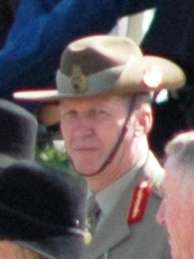 Peter Leahy
Peter Leahy
(2002–2008) Peter Cosgrove
Peter Cosgrove
(2000–2002) The official limousine of the Chief of Army at the 2008 National Anzac Day service, Australian War Memorial, Canberra.
The official limousine of the Chief of Army at the 2008 National Anzac Day service, Australian War Memorial, Canberra.
Images – Chief of the General Staff
- Phillip Bennett
(1982–1984) - Henry Wells
(1954–1958)  "Syd" Rowell
"Syd" Rowell
(1950–1954)
.jpg)
 John Lavarack
John Lavarack
(1935–1939) Julius Henry Bruche
Julius Henry Bruche
(1931–1935)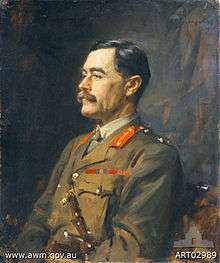 "Boss Gunner" Coxen
"Boss Gunner" Coxen
(1930–1931) "Harry" Chauvel
"Harry" Chauvel
(1923–1930)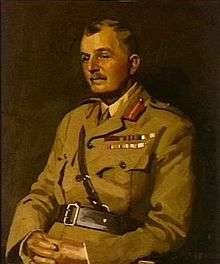
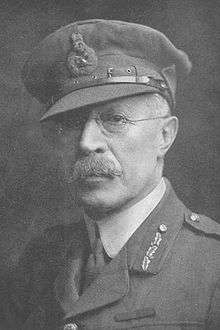 Joseph Gordon
Joseph Gordon
(1912–1914)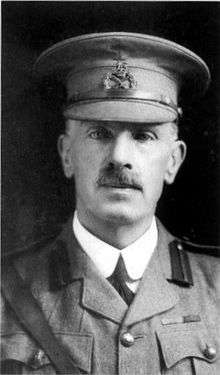 William Bridges
William Bridges
(1909)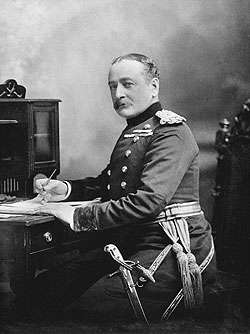 Edward Hutton
Edward Hutton
(1901–1909)
See also
Notes
- ↑ Wood 2006, p. 13
- ↑ Wood 2006, pp. 50–51
- ↑ Wood 2006, pp. xv–xxi
- ↑ Wood 2006, pp. 54–59
- ↑ Wood 2006, p. 66
- ↑ Palazzo 2001, p. 66
- ↑ Palazzo 2001, pp. 221–222
- ↑ Palazzo 2001, pp. 316–318
- ↑ Palazzo 2001, p. 323
- ↑ Beaumont 2001, pp. 75–76
References
- Beaumont, Joan (2001), Australian Defence: Sources and Statistics, South Melbourne, Victoria: Oxford University Press, ISBN 0-19-554118-9
- Palazzo, Albert (2001), The Australian Army: A History of Its Organisation 1901–2001, South Melbourne: Oxford University Press, ISBN 0-19-551506-4
- Wood, James (2006), Chiefs of the Australian army: Higher Command of the Australian Military Forces 1901–1914, Loftus, New South Wales: Australian Military History Publications, ISBN 1-876439-40-8
